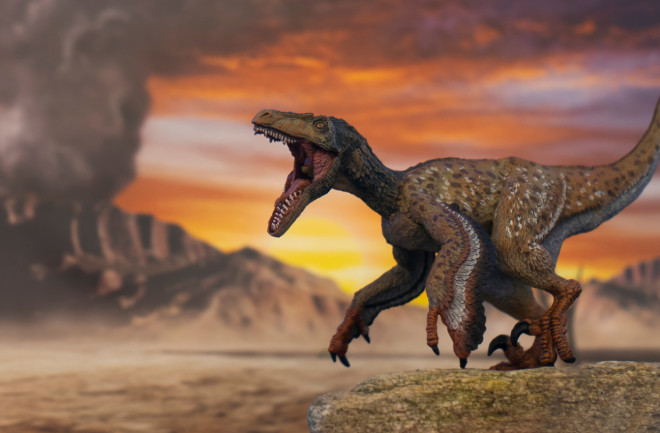Key Takeaways on How Dinosaurs Looked:
Based on fossil discoveries, many dinosaurs, including the velociraptor actually had long, bird-like feathers.
Dinosaurs had all sorts of fleshy appendages that came in a variety of colors.
We now know that dinosaurs behaved in lots of bird-like ways, and weren’t boring, fairly sluggish creatures.
If you were to meet a velociraptor, you wouldn’t be confronted with the tall, sleek and lizard-skinned beast from the hit Jurassic Park franchise.
Instead, you would likely face off against a much smaller, feathery and colorful creature.
Over the last few decades, scientists have learned a lot about what dinosaurs looked like — and that’s changing long-held beliefs.
New Evidence for Feathers and Skin
One of the most recent changes, says Paul Barrett, a researcher with the Natural History Museum in London, concerns the feathery coat of species such as the velociraptor.
“We now know from lots of fossils, in particular from China, that the relatives of velociraptor, and by extension velociraptor itself, was coated with feathers,” Barrett says. “They had very long, bird-like feathers on their forearms and downy feathers covering most of the rest of the body.”
The variety of plumage these meat-eaters sported was large. Caudipteryx, a diminutive theropod from the Early Cretaceous, had a tail fan full of feathers.
Meanwhile, researchers believe that the Caihong — from the Jurassic period — likely had shiny, iridescent feathers, possibly not too dissimilar from what we might see today on a hummingbird, says Sarah Davis, a postdoctoral researcher at the University of Texas.
Read More: Did All Dinosaurs Have Feathers?
Why Dinosaurs Were Colorful
Thanks to some well-preserved fossil finds and new research techniques, it’s also known that dinosaurs had all sorts of fleshy appendages. These came in a variety of colors.
In some cases, alongside fossilized feathers, archaeologists have also found fossilized melanosome structures, Davis says. “Those are pigments that make browns and greys and blacks,” she explains, citing the example of Anchiornis, which was a mostly black dinosaur from the Jurassic.
“This little, tiny, bird-like raptor dinosaur essentially had wings. It had these fluffy tail feathers on its back legs, as well as a long tail that could fan out,” Davis says. It also had white stripes running along its wings, she continues, and a brown head crest that was liked used as a display or in communication with others of its kind.
The Cretaceous period’s Psittacosaurus, as another example, had broom-like bristles on its tail and a range of markings on its body; in 2016, these findings allowed researchers to reconstruct the species in exquisite detail.
Read More: What Did Dinosaurs Sound Like?
Why Early Depictions Were Wrong
As exciting as it is to get a clearer glimpse of what dinosaurs actually looked like, however, researchers are more interested in what this tells us about possible dinosaur behavior.
“For most of the 20th century, dinosaurs were viewed as fairly boring, kind of sluggish animals — not very intelligent and not indulging in many behaviors,” he says. “We now know that dinosaurs behaved in lots of bird-like ways; they brooded their nests like birds, [and] they probably displayed a bit using their feathers like birds.”
One fossil from Canada revealed that Edmontosaurus — a “big, chunky, quadrupedal animal,” according to Barrett — was equipped with a fleshy crest on top of its head, likened to that of a rooster.
It’s thought that the headgear from this crested dinosaur was likely used as a “sexual display structure,” say the researchers who made the discovery.
Read More: How Scientists Reconstruct What Dinosaurs Looked Like
What Modern Birds Tell us About Dinosaurs
In a relatively short time period, our knowledge of what many dinosaurs looked like has expanded greatly. And Barrett and Davis both agree that these findings are opening the door to many other fascinating questions.
“I’m really interested in how dinosaurs could actually perceive color,” Davis says. “We know that birds in particular are able to see a wider array of colors than a lot of animals and that impacts the way they might be using colors for display.”
We even know now that the Tyrannosaurus, which usually is typically depicted with fearsome fangs on full display, actually had thin, lizard-like lips that hid their sharp, serrated teeth, according to a recent paper published in Science.
Whether these feathery displays and skin pigmentations lent themselves to a species-specific dino-vision is a question she hopes to tackle one day. “Are we kind of getting the superficial level of what dinosaurs looked like? And did they actually look completely different to each other?” Davis continues.
More to Come on What Dinosaurs Looked Like
While new discoveries often depend on finding a lucky, spectacularly preserved fossil specimen or on the development of new tech, Barrett believes more detailed knowledge of what dinosaurs looked like is on the horizon.
“Just in the length of my career, I've seen some really big changes that I think my predecessors wouldn't have thought were ever going to happen,” he says. “The pace of that change is increasing.”
Read More: What Species Today Are Descendants of Dinosaurs?
Article Sources
Our writers at Discovermagazine.com use peer-reviewed studies and high-quality sources for our articles, and our editors review for scientific accuracy and editorial standards. Review the sources used below for this article
Natural History Museum. Vicious Velociraptor: tales of a turkey-sized dinosaur
Natural History Museum. Caudipteryx
Nature Communications. A bony-crested Jurassic dinosaur with evidence of iridescent plumage highlights complexity in early paravian evolution
Science Direct. Melanosome
Pre-historic wildlife. Anchiornis
Palaeontology. Structure and homology of Psittacosaurus tail bristles
Natural History Museum. Edmontosaurus
Current Biology. A Mummified Duck-Billed Dinosaur with a Soft-Tissue Cock’s Comb
Science. Theropod dinosaur facial reconstruction and the importance of soft tissues in paleobiology
Sean Mowbray is a freelance writer based in Scotland. He covers the environment, archaeology, and general science topics. His work has also appeared in outlets such as Mongabay, New Scientist, Hakai Magazine, Ancient History Magazine, and others.



